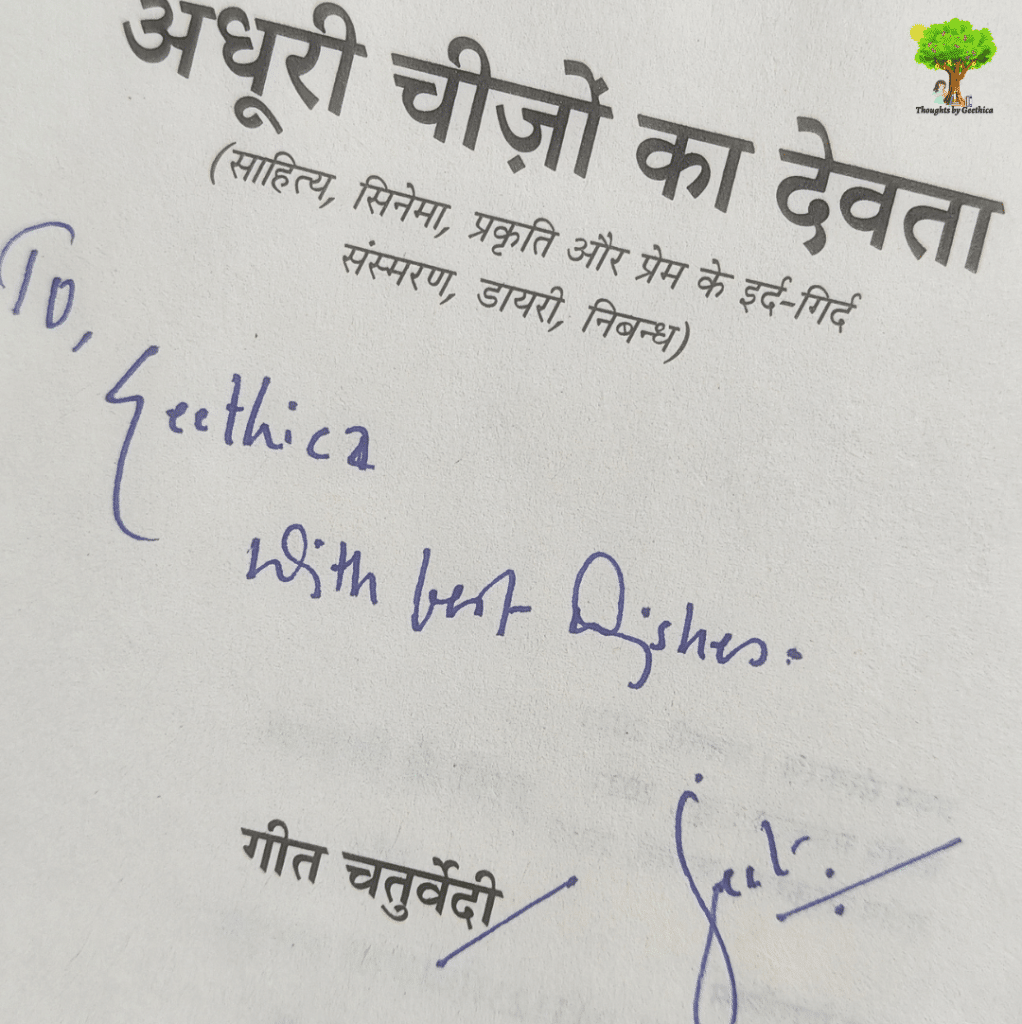Adhuri Cheezon ka Devta by Geet Chaturvedi
Adhuri Cheezon ka devta by Geet Chaturvedi is a reflection of life supported by true events. This book is divided into 3 phases, each of which takes you through various experiences of the author. This is my second book by the author and I must confess that his writing style resembles my thought process. His observation power is an extension of my way of processing life.
I heard of this book during the promotion of its English translation by Anita Gopalan. It was originally written in Hindi and I was excited to read another bestseller from my favourite author. Finally, I found the book on Amazon but for some strange reason, I wasn’t able to order it. A little disturbed, I searched for other ways to buy the book. I tried connecting with the author himself and asked if he could help me connect with the publisher and guess what? He sent me an author-signed book to my address! What more could I have asked for?

I thanked the author from the bottom of my heart and started my reading journey.
Everything happens for a reason
The author stresses the fact that every interaction you do leaves an impression on your character, adding to your experience and every action you take has a purpose, adding value to your learning. As I went deep into the chapters, my belief matched the author’s thinking technique.
The book includes his early life experiences as early as he can remember, his connection with his family members and how even a stray cat who became a regular visitor at his home left a significant emotional memory on his life.

As the author grew, he learned something or the other from every person he made friends with or his acquaintances he spent time discussing books with. The author even becomes a thief in the love of books and how beautifully he is made to realise his mistake by the book shop owner.
The right connection at the right time makes life easier
I found many chapters relatable as if the author is talking to me directly. He narrated many short stories as circumstantial examples from legendary people he had followed. Like a poem from the labour poets of Iran. It is amazing to know that even labourers think creatively and write prose. Aren’t they supposed to be working as heartless machines?
At many instances, I paused for a while to process the thoughts that the author was trying to convey through his essays. He is so right in saying you can’t escape life until death takes you away. You may disappear from the lives of your dear ones but you keep observing them from a distance without their knowledge because you are tied to them through destiny and until destiny itself sets you apart.
Just one bit more, where I want to tell you about my favourite chapter – Who do you write for? This chapter answers one of the main queries writers have. According to the author, you may research for your audience but the analytics won’t satisfy you as much as if someone comes to you and praises your hard work or recommends you to their friends.

There are many valid facts which you will agree upon as you read him more.
Adhuri Cheezon ka Devta by Geet Chaturvedi
In the end comes the best and appropriately placed chapter called Adhuri Cheezon ka Devta. A creative mind never settles for one thing and says it’s complete. A creator is always in action and wants to keep adding their experience along with facts and figures to support their story. Every place, person or situation alerts the writer’s mind and brings them back to writing their masterpiece and hence no story is ever complete. It’s always in the process.
The sweetest thing I liked about the author is that he reads books, listens to audiobooks and watches plays in translated works so that he can bring those back to his country and make them available in local languages. This way, he is expanding the reader base and knowledge of his people.
Watch my video review here
I can’t stop talking about the transparency of the book and how easily it melts into the reader’s mind but I should stop here so that you pick up the book and make your own memories.
The book is available in Hindi and English
Do read the book in your preferred language and tell me if my review helped you.



